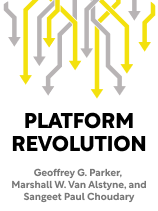

This article is an excerpt from the Shortform book guide to "Platform Revolution" by Geoffrey G. Parker, Marshall W. Van Alstyne, and Sangeet Paul Choudary. Shortform has the world's best summaries and analyses of books you should be reading.
Like this article? Sign up for a free trial here.
Is your business suffering from a lack of customers? Where do you find potential customers?
A business won’t get anywhere without customers. Geoffrey G. Parker, Marshall W. Van Alstyne, and Sangeet Paul Choudary stress that to attract users to your platform, you must ensure your platform has obvious inherent value.
Continue reading to learn how to attract customers.
How to Recruit Users to Your Platform
One way to know how to attract customers is by ensuring that users can use your platform to make valuable connections in a straightforward, pleasant way—if it’s a hassle, users will lose interest. The authors list three strategies to attract users: First, promote easy access to your platform (for example, don’t charge a fee or require an ID for users to join) to increase your user base. Second, balance easy access with selectivity—don’t let low-quality users enter or remain on your platform. Third, utilize user data, like reports of abuse and activity patterns, to inform your decisions about selectivity and recommend high-quality connections.
(Shortform note: The authors’ recommended strategies for attracting users can help your platform garner attention, retain a high-quality user base, and facilitate valuable connections, but experts suggest these effects are only worthwhile if your platform is also easy to use. A platform’s usability is determined by its technological design and includes aspects such as simple forms, clear and aesthetically pleasing text, and search functionality. Usability is one of the key characteristics consumers look for when they’re considering whether to adopt a new platform, so experts say developers should design platforms with key usability considerations in mind.)
New platforms also face a unique challenge—determining how to attract producers when there are no consumers yet, or vice versa, since the platform is only valuable if both types of users are active. The authors discuss several strategies you can use to address this challenge encouraging you to mix and match strategies to find the best approach for your platform:
Strategy #1: Piggyback on a pipeline. If you build a platform that has obvious value because it’s comparable to pipeline businesses in the same market, it’ll be easier to convince users to sign up. For example, Uber has obvious value as an alternative to traditional taxi companies.
(Shortform note: If you’re struggling to find a comparable pipeline to piggyback on, an alternative strategy is to partner with a pipeline and tap into its user base. For example, experts explain that while pipeline-based grocery delivery services have failed in the past, the grocery delivery platform Instacart has succeeded because it leveraged partnerships with existing grocery stores (pipelines) to create a network consisting of their shoppers.)
Strategy #2: Generate buzz with a small initial network. If you capture a very small percentage of potential users and gain publicity by proving your value, it’ll be easier to scale up later. For example, Pinterest used an invite-only model to create exclusivity and generate early interest before widening access.
(Shortform note: Uber executive Andrew Chen recommends Strategy #2 in The Cold Start Problem. Chen explains that you can attract your initial network by targeting an extremely niche market and ensuring your platform meets users’ unique needs. Chen also emphasizes that you need both producers and consumers for this approach to work, so you should cater to whichever type of user is more difficult to attract until you reach a point of stability. Then, you can repeat this process to attract other niche networks, gradually building your platform’s overall network. Eventually, you’ll accumulate enough users to reach exponential network growth.)
Strategy #3: Recruit key consumers or producers, but not both. If you retain a subset of clearly valuable users, users of the other type will soon flock to your platform. For example, the celebrity video message platform Cameo started off with minor-league celebrities to draw in the fans who wanted to hear from them.
(Shortform note: How do you convince producers to join your platform when there aren’t any consumers, or vice versa? One strategy is to pay them to use the service—Cameo’s CEO says he paid its first star $150 an hour, and as a startup, Uber paid drivers to stay online so that riders could have access to a reliable service. This requires access to a sum of cash upfront—but you can make up your losses later, when money is flowing between consumers and producers on your platform and users are more willing to pay to use it.)
Strategy #4: Choreograph an exemplary product launch. If you accumulate exemplary offerings from key producers, consumers will be more inclined to engage with your platform from the beginning, fostering trust and loyalty. For example, Spotify started out with a limited library of streamable music to attract consumers and then expanded its library as it grew.
(Shortform note: In Launch, entrepreneur Jeff Walker offers three tips you can use to optimize your product launch: First, stretch your launch out over days or weeks. This gives users a chance to discuss your platform with others, generating good publicity. Second, use a countdown with a definite endpoint to engender a sense of urgency and excitement among your users. This can help motivate users to join your platform. Finally, generously offer no-cost value to your users before you ask them to pay for something (for example, by launching a free version of the platform first). This can build users’ trust in your platform, making them more willing to spend money down the line.)

———End of Preview———
Like what you just read? Read the rest of the world's best book summary and analysis of Geoffrey G. Parker, Marshall W. Van Alstyne, and Sangeet Paul Choudary's "Platform Revolution" at Shortform.
Here's what you'll find in our full Platform Revolution summary:
- How platforms like Spotify and Amazon became so successful
- What makes platform businesses so unique and competitive
- Tips for aspiring platform entrepreneurs






